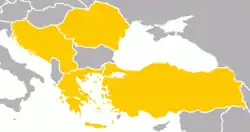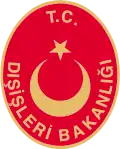Balkan Pact
The Balkan Pact, or Balkan Entente, was a treaty signed by Greece, Turkey, Romania and Yugoslavia on 9 February 1934[1] in Athens,[2] aimed at maintaining the geopolitical status quo in the region following World War I. To present a united front against Bulgarian designs on their territories, the signatories agreed to suspend all disputed territorial claims against each other and their immediate neighbors which followed in the aftermath of the war and a rise in various regional ethnic minority tensions. Other nations in the region that had been involved in related diplomacy refused to sign the document, including Italy, Albania, Bulgaria, Hungary and the Soviet Union. The pact became effective on the day that it was signed. It was registered in the League of Nations Treaty Series on 1 October 1934.[3]
Balkan Entente Βαλκανικό Σύμφωνο Balkan Antantı Înțelegerea Balcanică Балкански пакт Balkanski pakt | |
|---|---|
| 1934-1941 | |
 Members of the Balkan Pact
Balkan Pact:
| |
| Status | Military alliance |
| Historical era | Interwar |
• Formation | 9 February 1934 |
| 6 April 1941 | |
The Balkan Pact helped to ensure peace between the signatory nations but failed to stop regional intrigues. Although the countries of the pact surrounded Bulgaria, on 31 July 1938, they signed the Salonika Agreement with Bulgaria. It repealed the clauses of the Treaty of Neuilly-sur-Seine and Treaty of Lausanne that had mandated demilitarised zones at Bulgaria's borders with Greece and Turkey, which allowed Bulgaria to rearm.
With the 1941 Axis invasion of Yugoslavia the pact effectively ceased to exist.
See also
References
- Pact of Balkan Agreement Between Yugoslavia, Greece, Romania and Turkey Archived 2014-02-22 at the Wayback Machine
- Army History Directorate, An Abridged History of the Greek-Italian and Greek-German War, 1940–1941: Land Operations, Hellenic Army General Staff, Army History Directorate, 1997, p. 2.
- League of Nations Treaty Series, vol. 153, pp. 154-159.
.png.webp)

